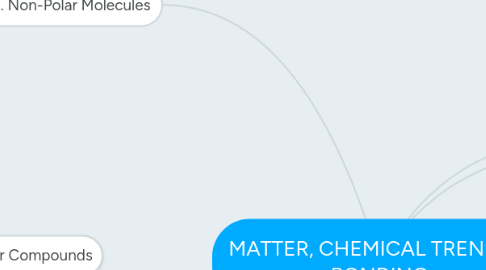MATTER, CHEMICAL TRENDS & BONDING
by Virk Manraj


1. Ionic vs. Molecular Compounds
1.1. Ionic Compound
1.2. Common Properties
1.2.1. solids at room temperature definite geometries hard + brittle high melting & boiling points conduct electricty as molten liquids not solid conduct eletricity when dissolved in water
1.3. Molecular Compound
1.3.1. Common Properties
1.3.1.1. Molecular substances exist as: gases, liquids & solids at room temperature Variety of textures: waxy- soft low boiling points and melting points Don't readily dissolve in water
2. Polar vs. Non-Polar Molecules
2.1. Polar Molecules
2.1.1. 1 positive & 1 negative charged end
2.2. Non-Polar Molecules
2.2.1. In symmetricl linear molecule positive and negative cancel each other out

